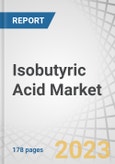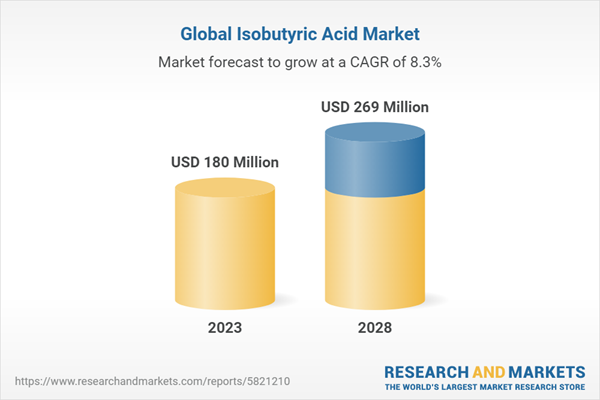The isobutyric acid market is projected to grow from USD 180 million in 2023 to USD 269 million by 2028, at a CAGR of 8.3% from 2023 to 2028. The isobutyric acid market is on the way to intense growth due to different end-uses including animal feed, food & flavor, pharmaceutical, chemical intermediate, and others.
By type, renewable isobutyric acid is expected to be the second-larger segment during 2023 to 2028, by value
Based on type, renewable isobutyric acid is expected to account for the second-larger market share. Renewable isobutyric acid is derived from renewable or sustainable feedstocks instead of fossil fuels. It is produced through biosynthesis of glucose or starch. There is less production of renewable isobutyric acid as compared to synthetic one due to high cost. Also, synthetic isobutyric acid is majorly manufactured due to easy availability of petroleum feedstocks used as raw materials. But with the increasing customer preference towards bio-based products, the market for renewable isobutyric acid will grow.
By end-use, chemical intermediate is expected to be the second-largest segment during 2023 to 2028, by value
The chemical intermediate segment is expected to account for the second-largest market share owing to its wide usage in the production of various chemicals. Chemical intermediates are substances that act as raw materials or building blocks in the production of more complicated chemicals. The factors influencing the use of isobutyric acid as a chemical intermediate are desired properties, the target compound, and the specific requirements of the desired application.
By region, Europe is expected to be the second-largest segment during 2023 to 2028, by value
Europe is projected to account for the second-largest market share from 2023 to 2028. The region is home to one of the largest feed industries globally. There is a rising need for good feed additives to boost animal health and performance due to the growing consumption of meat and meat products in the region. This creates opportunity for potential use of isobutyric acid in animal feed. Also, the rising demand for processed food and growth in pharmaceutical sectors in European countries are expected to propel the demand for isobutyric acid.
Profile break-up of primary participants for the report:
- By Company Type: Tier 1 - 65%, Tier 2 - 20%, and Tier 3 - 15%
- By Designation: C-level Executives - 25%, Directors - 30%, and Others - 45%
- By Region: North America - 20%, Europe - 15%, Asia Pacific - 55%, Middle East & Africa - 3%, South America - 7%
The isobutyric acid report is dominated by players, such as OQ Chemicals GmbH (Germany), Eastman Chemical Company (US), Tokyo Chemical Industry Co., Ltd. (Japan), Snowco (China), Shanghai Aladdin Biochemical Technology Co., Ltd. (China), Afyren (France), Lygos, Inc. (US), Dow Inc. (US), Jiangsu Dynamic Chemical Co., Ltd. (China), Weifang Qiyi Chemical Co., Ltd. (China), Yufeng International Group Co., Ltd. (China), Nanjing Chemical Material Corp. (China), FUJIFILM Wako Pure Chemical Corporation (Japan), Hubei Jusheng Technology Co., Ltd. (China), and others.
Research Coverage:
The report defines, segments, and projects the size of the isobutyric acid market based on type, end-use, and region. It strategically profiles the key players and comprehensively analyzes their market share and core competencies. It also tracks and analyzes competitive developments, such as mergers, investments, acquisitions, expansions, partnerships, contracts, agreements, and joint ventures undertaken by them in the market.
Reasons to Buy the Report:
The report is expected to help the market leaders/new entrants in the market by providing them with the closest approximations of revenue numbers of the isobutyric acid market and its segments. This report is also expected to help stakeholders obtain an improved understanding of the competitive landscape of the market, gain insights to improve the position of their businesses and make suitable go-to-market strategies. It also enables stakeholders to understand the pulse of the market and provide them information on key market drivers, restraints, challenges, and opportunities.
The report provides insights on the following pointers:
- Analysis of key drivers (use of isobutyric acid in food & flavor, and animal feed industries), restraints (health concerns associated with handling and storage of isobutyric acid), opportunities (recent developments in the pharmaceutical industry, and growing demand for bio-based isobutric acid), and challenges (price volatility of raw materials) influencing the growth of the isobutyric acid market.
- Product Development/Innovation: Detailed insights on upcoming technologies, research & development activities in the isobutyric acid market.
- Market Development: Comprehensive information about lucrative markets - the report analyses the isobutyric acid market across varied regions.
- Market Diversification: Exhaustive information about new products, various production technologies, untapped geographies, recent developments, and investments in the isobutyric acid market.
- Competitive Assessment: In-depth assessment of market shares, growth strategies and service offerings of leading players such as OQ Chemicals GmbH (Germany), Eastman Chemical Company (US), Tokyo Chemical Industry Co., Ltd. (Japan), Snowco (China), Shanghai Aladdin Biochemical Technology Co., Ltd. (China), among others in the isobutyric acid market.
Table of Contents
Companies Mentioned
- Afyren Sas
- Eastman Chemical Company
- Jiangsu Dynamic Chemical
- Kunshan Odowell Co., Ltd.
- Lygos, Inc.
- Oq Chemicals GmbH
- Shanghai Aladdin Biochemical Technology Co. Ltd.
- Shanghai Danfan Network Science&Technology Co. Ltd.
- Sisco Research Laboratories Pvt. Ltd.
- Snowco Industrial Co. Ltd.
- TCI Chemicals (India) Pvt. Ltd.
- Weifang Qiyi Chemical Co. Ltd.
- Wen International, Inc.
- Yancheng City Chunzhu Aroma Co., Ltd.
Methodology

LOADING...
Table Information
| Report Attribute | Details |
|---|---|
| No. of Pages | 178 |
| Published | June 2023 |
| Forecast Period | 2023 - 2028 |
| Estimated Market Value ( USD | $ 180 Million |
| Forecasted Market Value ( USD | $ 269 Million |
| Compound Annual Growth Rate | 8.3% |
| Regions Covered | Global |
| No. of Companies Mentioned | 14 |









